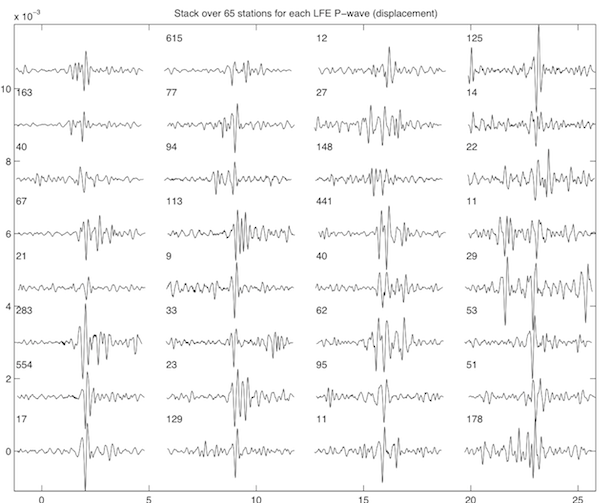2012 IRIS Workshop
Slow Rupture Speed of Low Frequency Earthquakes
Ken Creager: U. Washington, Justin Sweet: U. Washington
Displacement source-time functions for thirty two Low Frequency Earthquakes (LFEs). Vertical-component displacement seismograms at 65 stations of the 1-km aperture Big Skidder Array are bandpass filtered between 2 and 25 Hz and stacked for each of 32 distinct events. Each trace is 6-s long; the numbers between vertical pairs of events indicate the time (s) separating the events. Only P waves are shown.

Full-resolution graphics file in original format: 0117.ps
In 2008 we deployed a 1-km aperture array of 80 sensors on the Olympic Peninsula at Big Skidder Hill. The figure shows the results from 65 of those stations, which have average spacing of about 100 m. The lower left LFE shows the simplicity of the Green’s functions for these events so that much of the structure of the other LFEs is related to the source-time function itself. The duration of these LFEs often exceeds 2 s. Though not shown, we cross correlate the P waves of a reference event with the P waves of the other LFES and stack the correlation functions across the stations. We do the same for the S waves and find that the peaks in the P- and S-wave correlation functions vary by only a couple of hundredths of a second meaning that the S minus P times of these LFEs differ by the same amount. This suggests that the centroids of these LFEs are within a couple hundred meters of each other which inturn suggests that the spatial dimensions of the fault that is rupturing is less than a couple hundred meters. Comparing this source dimension with the 2 or more s durations implies that the rupture velocity is less than 100 m/s, very slow relative to normal earthquakes.
Acknoweldgements: The research and seismic data collection effort were funded by NSF/EarthScope.
Keywords: cascadia, tremor, slow_slip, low_frequency_earthquakes, rupture_speed
